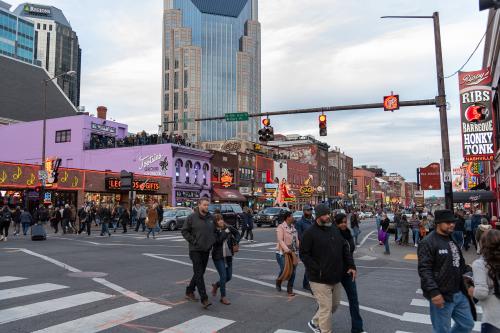On Thursday, January 11, Brookings hosted a discussion on President Trump’s immigration policies and proposed border wall. A full recording of the event is available, as well as a video produced by the Brookings Creative Lab that explores the tough terrain a border wall would have to navigate.
President Trump has rarely been at a loss for words when it comes to immigration policy. On the campaign trail and through his first year in office, his calls for a crackdown on undocumented immigration, for increased border security, and for the construction of a border wall have been among his most iconic policy positions.
This week, tensions around immigration are high as Congress and the White House try to negotiate a deal to fund the border security, and also to allow permanent legal status to hundreds of thousands of “Dreamers,” immigrants who came to the United States as children and who were protected by the Deferred Action on Childhood Arrivals program (DACA).
Significant questions remain about how much an actual border wall would cost and what affect it would have on the people and environment along the border. In “The Wall: The real costs of a barrier between the U.S. and Mexico,” a Brookings Essay published in August 2017, Foreign Policy Senior Fellow Vanda Felbab-Brown analyzed these questions and more, and explained the impacts, if any, a border wall would have on crime, drug trafficking, and the U.S. economy.
To discuss the findings of her essay and to better understand the real costs of a border wall, Brookings hosted a discussion between Felbab-Brown, Representative Henry Cuellar (D-Texas), and Maria Peña, correspondent for La Opinión-Impremedia. Below are a few highlights of their conversation.
How funding for the government is tied to funding for the wall and the legal protections for Dreamers
The current continuing resolution (CR) funding the federal government is set to expire on January 19. Congress will have to pass a new spending bill before then or face a partial government shutdown. Republicans, with their Senate majority, will need the support of at least nine Democrats to pass a new CR, but many Democrats have signaled that they may withhold their votes until action is taken to protect Dreamers. Republicans for their part may use spending bill negotiations to add several billion dollars for increased border security.
As Rep. Cuellar pointed out, Democrats have leverage in this situation, but he personally disagrees with playing politics with continuing resolutions. Rep. Cuellar explains that while he supports the DACA program, he doesn’t believe Democrats should shut down the government for a single issue.
A wall will not stop drug cartels or reduce violent crimes
President Trump famously began his presidential campaign in 2015 by saying Mexicans are “bringing drugs” and “bringing crime” into the United States. Since then, he has often invoked anecdotal cases of violence committed by undocumented immigrants in order to legitimize immigration as an issue.
In the essay and in the clip below, Felbab-Brown observes that “there is no evidence whatsoever that undocumented residents account for [a] significant amount of crime in the United States.” In fact, the vast majority of violent crimes are committed by native-born Americans.
Felbab-Brown also explained how “anti-community policing” promoted by the Trump administration—including attacking sanctuary cities, pardoning well-known Arizona Sheriff Joe Arpaio, and forcing police departments to prioritize raids in Latino communities—could jeopardize the relationship these communities have with local law enforcement and worsen crime in the United States.
Felbab-Brown also detailed a number of reasons why a wall would not stop the flow of contraband, including the use of tunnels, drones, and shipping ports. She cites the United States’ strategic relationship with Mexico, current intelligence sharing, and the ability to mount coordinated actions as effective means to reduce drug smuggling, but warns that this will all be lost if the relationship between the two countries becomes more hostile.
More than just a concrete structure, a wall would be a reflection of American society
The ramifications of a border wall would be far more than just the physical change to the landscape, and will be felt far beyond the border itself. According to Felbab-Brown, paired with other policies the Trump administration has pursued, the wall “is not simply about creating a physical structure but about creating barriers and divisions in one’s mind and promoting politics of exclusion and bigotry.”
What would smart border security policies look like?
Near the end of the event, Maria Peña asked each panelist to briefly share what they believe a “smart” border security plan would look like. Felbab-Brown emphasized the importance of investing money in elements of border security other than a physical wall, including legal ports of entry, border agents, and the Coast Guard. She also recommends that Americans think of the border as something more than just a line of separation with a structure on it, but rather as a membrane of connection in a larger organic environment.
Rep. Cuellar focused on investments that should be made in communities located close to the border, like his own in the Texas’s 28th District, and why an increase in immigration judges should accompany any investment in greater border security.
For a full recording of the event please click here, and be sure to also watch a video exploring the rough terrain a border wall would have to navigate produced by Brookings Creative Lab.




Commentary
The Wall: A conversation with Rep. Henry Cuellar and Brookings expert Vanda Felbab-Brown
January 12, 2018